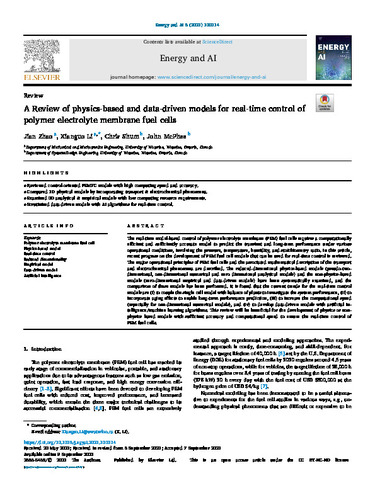| dc.contributor.author | Zhao, Jian | |
| dc.contributor.author | Li, Xianguo | |
| dc.contributor.author | Shum, Chris | |
| dc.contributor.author | McPhee, John | |
| dc.date.accessioned | 2022-01-26 19:15:36 (GMT) | |
| dc.date.available | 2022-01-26 19:15:36 (GMT) | |
| dc.date.issued | 2021-12 | |
| dc.identifier.uri | https://doi.org/10.1016/j.egyai.2021.100114 | |
| dc.identifier.uri | http://hdl.handle.net/10012/17987 | |
| dc.description.abstract | The real-time model-based control of polymer electrolyte membrane (PEM) fuel cells requires a computationally efficient and sufficiently accurate model to predict the transient and long-term performance under various operational conditions, involving the pressure, temperature, humidity, and stoichiometry ratio. In this article, recent progress on the development of PEM fuel cell models that can be used for real-time control is reviewed. The major operational principles of PEM fuel cells and the associated mathematical description of the transport and electrochemical phenomena are described. The reduced-dimensional physics-based models (pseudo-two-dimensional, one-dimensional numerical and zero dimensional analytical models) and the non-physics-based models (zero-dimensional empirical and data-driven models) have been systematically examined, and the comparison of these models has been performed. It is found that the current trends for the real-time control models are (i) to couple the single cell model with balance of plants to investigate the system performance, (ii) to incorporate aging effects to enable long-term performance prediction, (iii) to increase the computational speed (especially for one-dimensional numerical models), and (iv) to develop data-driven models with artificial intelligence/machine learning algorithms. This review will be beneficial for the development of physics or non-physics based models with sufficient accuracy and computational speed to ensure the real-time control of PEM fuel cells. | en |
| dc.description.sponsorship | Toyota Motor Engineering & Manufacturing North America || Natural Sciences and Engineering Research Council of Canada | en |
| dc.language.iso | en | en |
| dc.publisher | Elsevier | en |
| dc.relation.ispartofseries | Energy and AI; | |
| dc.rights | Attribution-NonCommercial-NoDerivatives 4.0 International | * |
| dc.rights.uri | http://creativecommons.org/licenses/by-nc-nd/4.0/ | * |
| dc.subject | polymer electrolyte membrane fuel cell | en |
| dc.subject | physics-based model | en |
| dc.subject | real-time control | en |
| dc.subject | reduced dimensionality | en |
| dc.subject | empirical model | en |
| dc.subject | data-driven model | en |
| dc.subject | artificial intelligence | en |
| dc.title | A Review of physics-based and data-driven models for real-time control of polymer electrolyte membrane fuel cells | en |
| dc.type | Article | en |
| dcterms.bibliographicCitation | Zhao, J., Li, X., Shum, C., & McPhee, J. (2021). A Review of physics-based and data-driven models for real-time control of polymer electrolyte membrane fuel cells. Energy and AI, 6, 100114. https://doi.org/10.1016/j.egyai.2021.100114 | en |
| uws.contributor.affiliation1 | Faculty of Engineering | en |
| uws.contributor.affiliation2 | Mechanical and Mechatronics Engineering | en |
| uws.typeOfResource | Text | en |
| uws.peerReviewStatus | Reviewed | en |
| uws.scholarLevel | Faculty | en |


